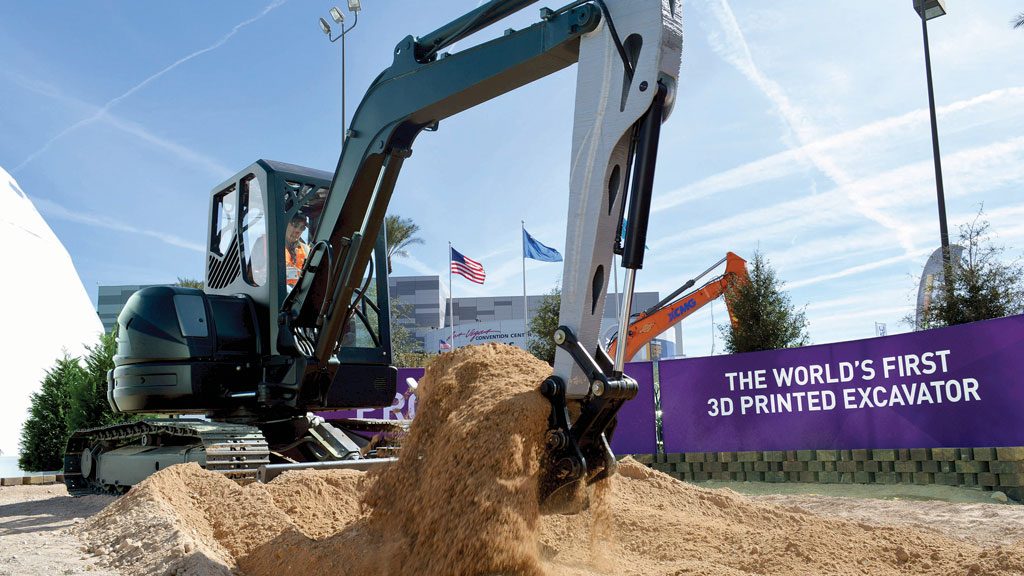The construction vehicle parked outside the offices of the Oak Ridge National Laboratory (ORNL) in Tennessee doesn’t belong to a local contractor.
It’s the world’s first-ever 3-D printed excavator project, produced at the U.S. Department of Energy’s manufacturing demonstration facility at the ORNL.
The drive to build the prototype began with a casual comment in 2014 when a member of the National Fluid Power Association threw out a challenge to Lonnie Love, who heads the 3-D printed excavator project with ORNL’s manufacturing systems research group.
“He said that he’d love for us to produce a 3-D printed excavator and have it ready for the 2017 CONEXPO trade show,” says Love. “I jokingly answered that if they would send us an excavator, we would see what we could do.”
After a Case New Holland backhoe excavator was delivered to the ORNL headquarters, Love committed himself to the project. Dubbed Project AME (Additive Manufactured Excavator) the three-year partnership united the efforts of the ORNL, the Association of Equipment Manufacturers, the National Fluid Power Association, the Center for Compact and Efficient Fluid Power and the National Science Foundation among other industry partners. The researchers also worked with students from the University of Illinois, the University of Minnesota, and Georgia Tech to create designs for the components.
“We examined the excavator and then looked at which major components we could reverse-engineer and replace in a way that would demonstrate the potential for large-scale additive manufacturing,” says Love.
Project AME focused on the excavator’s operator cab, hydraulic arm and heat exchanger. The cab was printed on the Cincinnati Incorporated Big Area Additive Manufacturing system in five hours using carbon fibre-reinforced ABS plastic. The 13-pound aluminum heat exchanger was printed on a Concept Laser X-line 1000 powder bed machine. The 400-pound hydraulic arm measures seven feet long, two feet across and a foot thick and was produced on a Wolf Robotics Wolf Pack printer over five days using low-cost steel.

“The hydraulic arm represented a real innovation in large-scale additive manufacturing,” says Love. “We were also able to introduce some design improvements into the arm. We incorporated the metal tubing for hydraulic lines inside the arm structure, using the capabilities of the printer to produce complex designs.”
Following development of the initial designs, Project AME had a tight timeline of between eight and nine months to “grow” and install the parts required to deliver the prototype to the International Fluid Power Exposition and CONEXPO show in Las Vegas.
“We grew multiple versions of the components we were replacing and did a lot of technical testing,” says Love. “But to be honest, the first time we used the hydraulic arm to actually dig into the dirt was at the successful live demonstration onsite at CONEXPO.”
Love notes that additive manufacturing isn’t ready to take on mass production of manufactured parts any time soon, but it’s perfectly poised to handle small runs of high-complexity components of the type found in construction equipment.
“That could reduce production time and overall cost, using low-cost alloys like steel and aluminum,” says Love. “Employing additive manufacturing on demand could also eliminate the need to store or transport these parts. The key to leveraging 3-D printing is understanding where its strengths lie and for now that appears to be one-of-a-kind parts of high value that require long manufacturing lead times.”
The ORNL continues to improve on the design and efficiency of large-scale 3-D printing projects, including the production of smaller V8 engine blocks. Love notes the key to more widespread opportunities for additive manufacturing will be improving the speed at which the additive printers deposit material.
In the meantime, Project AME stands vigil in the parking lot at the ORNL.
“As a functional excavator, it doesn’t get lonely,” says Love. “Every now and then we’ll have someone go outside and use it to dig a hole.”






Recent Comments